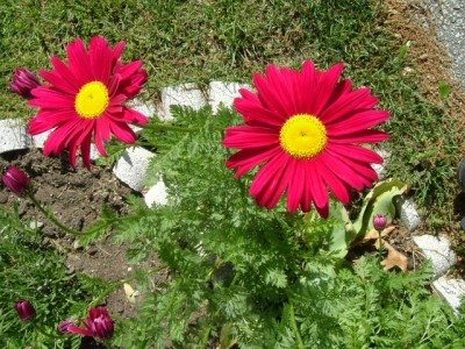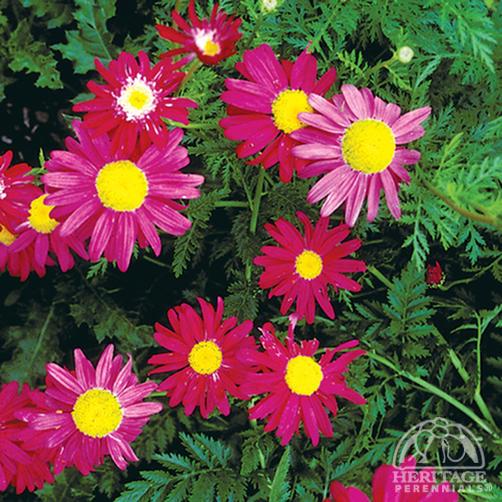Red Painted Daisy
Tanacetum coccineum (Pyrethrum) 'Robinson's Red'
Help keep your garden pest-free! Brilliant long-lasting blooms in June through July. Most insects can't tolerate flowering Pyrethrum, it helps keep your garden pest free. 6" tall. Field grown plants. Zones 3-8.
Tanacetum coccineum Robinson’s mix
Single Painted DaisyUSDA Zone: 2-9Plant number: 1.508.160
(Formerly Chrysanthemum coccineus) Painted Daisies are old-fashioned perennials that have always been popular as cut flowers. Foliage is bright green and ferny, with upright stems bearing loads of single yellow-eyed daisies, in shades of white, pink or crimson red. Remove faded flower to encourage more buds to form. Plants may be trimmed hard after blooming to rejuvenate the foliage. Easily divided in spring or fall. These are a nice addition to any sunny border, and also useful in containers or tubs.
Further details for
Tanacetum coccineum Robinson’s mixOptimal Growing Conditions
Sun Exposure
Full SunSoil Type
Normal or
Sandy or
ClaySoil pH
Neutral or
Alkaline or
AcidSoil MoistureCare Level
Easy
Appearance and Characteristics
Flower Colour
Deep Pink
Light Pink
Mixed
Red
White
Blooming Time
Early Summer
Mid SummerFoliage Color
Deep Green
Plant Uses & Characteristics
Accent: Good Texture/Form
Attracts Butterflies
Attracts Hummingbirds
Border
Containers
Cut Flower
Deer Resistant
Massed
Flower Head Size
Large
Height
45-75 cm
18-29 inches
Spread
30-45 cm
12-18 inches
Foot Traffic
None
Growth Rate
Medium
Single Painted DaisyUSDA Zone: 2-9Plant number: 1.508.160
(Formerly Chrysanthemum coccineus) Painted Daisies are old-fashioned perennials that have always been popular as cut flowers. Foliage is bright green and ferny, with upright stems bearing loads of single yellow-eyed daisies, in shades of white, pink or crimson red. Remove faded flower to encourage more buds to form. Plants may be trimmed hard after blooming to rejuvenate the foliage. Easily divided in spring or fall. These are a nice addition to any sunny border, and also useful in containers or tubs.
Further details for
Tanacetum coccineum Robinson’s mixOptimal Growing Conditions
Sun Exposure
Full SunSoil Type
Normal or
Sandy or
ClaySoil pH
Neutral or
Alkaline or
AcidSoil MoistureCare Level
Easy
Appearance and Characteristics
Flower Colour
Deep Pink
Light Pink
Mixed
Red
White
Blooming Time
Early Summer
Mid SummerFoliage Color
Deep Green
Plant Uses & Characteristics
Accent: Good Texture/Form
Attracts Butterflies
Attracts Hummingbirds
Border
Containers
Cut Flower
Deer Resistant
Massed
Flower Head Size
Large
Height
45-75 cm
18-29 inches
Spread
30-45 cm
12-18 inches
Foot Traffic
None
Growth Rate
Medium
Red Painted Daisy
Tanacetum coccineum (Pyrethrum) 'Robinson's Red'Help keep your garden pest-free! Brilliant long-lasting blooms in June through July. Most insects can't tolerate flowering Pyrethrum, it helps keep your garden pest free. 6" tall. Field grown plants. Zones 3-8.
When you want a pop of low-maintenance color in your garden, consider planting painted daisies (Chrysanthemum coccineum). These perennial flowers grow in U.S. Department of Agriculture plant hardiness zones 2 through 9 and come in a wide variety of colors, including the rich reds of the “Robinson’s Red” and “James Kelway” varieties. Plant painted daisies 12 to 24 inches apart in a sunny area of the garden with well-drained soil. Provide afternoon shade where summer temperatures reach extremes.
1 Pinch back new growth in early spring when the shoots are 6 to 8 inches long to encourage a bushier, fuller plant.
2 Fertilize painted daisies once in early spring and again in late spring or early summer with a balanced fertilizer. Stop fertilizing when the new daisies begin to bloom. The first blooms typically appear in May or June but may arrive in April after a mild winter. After the first bloom, apply a fertilizer that is low in nitrogen but high in phosphorous and potassium to encourage more blooms and fewer leaves.
3 Water the daisies as needed to supplement rainfall and keep the soil moist. Allow the soil to dry out between waterings. Daisies are drought tolerant but fail to thrive in wet, poorly draining soils. The plant will tell you what to do – painted daises that are getting too little water will develop thick, woody stems; those that are getting too much will have foliage that turns yellow and then black.
4 Deadhead spent flowers by cutting them off just above a healthy lateral bud, flower or leaf. When all the blooms on a stem have died, cut the stem back to its bottom leaves to encourage a second round of blooms.
5 Stake large plants if they become top-heavy or lean to one side.
Things You Will Need
1 Pinch back new growth in early spring when the shoots are 6 to 8 inches long to encourage a bushier, fuller plant.
2 Fertilize painted daisies once in early spring and again in late spring or early summer with a balanced fertilizer. Stop fertilizing when the new daisies begin to bloom. The first blooms typically appear in May or June but may arrive in April after a mild winter. After the first bloom, apply a fertilizer that is low in nitrogen but high in phosphorous and potassium to encourage more blooms and fewer leaves.
3 Water the daisies as needed to supplement rainfall and keep the soil moist. Allow the soil to dry out between waterings. Daisies are drought tolerant but fail to thrive in wet, poorly draining soils. The plant will tell you what to do – painted daises that are getting too little water will develop thick, woody stems; those that are getting too much will have foliage that turns yellow and then black.
4 Deadhead spent flowers by cutting them off just above a healthy lateral bud, flower or leaf. When all the blooms on a stem have died, cut the stem back to its bottom leaves to encourage a second round of blooms.
5 Stake large plants if they become top-heavy or lean to one side.
Things You Will Need
- Balanced fertilizer
- Low-nitrogen fertilizer
- Pruning shears or scissors
- Stake (optional)
- Twine (optional)

